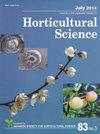Role of Temperature in Dormancy Induction and Release in One-year-old Seedlings of Lilium longiflorum Populations
Journal of The Japanese Society for Horticultural Science
Pub Date : 2013-01-01
DOI:10.2503/JJSHS1.82.63
引用次数: 14
Abstract
The role of temperature in bulb dormancy induction and release was investigated in one-year-old seedlings of three populations of Lilium longiflorum, i.e., Yakushima (LYA) and Kikaijima (LKI) in the Ryukyu Archipelago, Japan and Pitouchiao (LPI), Taiwan, and two populations of L. formosanum, Wulai (FWU), Taiwan and domesticated Fukuoka population (FFU), Japan. LYA and LKI undergo deep summer dormancy, while LPI, FWU and FFU do not. Four weeks of high temperature induced dormancy in LYA and LKI, whereas two weeks of high temperature was insufficient. Dormancy was not induced in LPI and FFU even after eight weeks of high temperature. Re-growth after dormancy was initiated in LKI and LYA six to eight weeks after shifting to 15°C. In the temperature-controlled experiment, all the populations continued developing new leaves at 15°C for 22 weeks, and stopped leaf production at 20 and 25°C in winter, while FFU produced new leaves at 30°C. It is considered that summer dormancy induction and release in one-year-old seedlings of northern ecotypes of L. longiflorum is determined by the duration of high and low temperature, respectively. It was proved that development of nonor weakly dormant ecotypes of L. longiflorum and L. formosanum is associated with the lack or reduction of sensitiveness to high temperature.温度在长花百合1年生群体休眠诱导和释放中的作用
以日本琉球群岛的屋久岛(LYA)和菊岛(LKI)、台湾的Pitouchiao (LPI)三个百合种群、台湾的五来(FWU)和日本福冈驯化种群(FFU) 2个百合种群为研究对象,研究了温度在百合球茎休眠诱导和释放中的作用。LYA和LKI处于夏季深度休眠状态,而LPI、FWU和FFU则没有。4周高温诱导LYA和LKI休眠,2周高温不足。即使高温8周,LPI和FFU也未引起休眠。在LKI和LYA中,休眠后的再生长在转移到15°C后的6至8周开始。在温控实验中,所有群体在15°C下继续长新叶22周,冬季在20和25°C时停止长叶,而FFU在30°C时长新叶。认为北方生态型长花l一年生幼苗夏季休眠的诱导和释放分别取决于高温和低温的持续时间。结果表明,长花L.和台湾L.的非或弱休眠生态型的发育与高温敏感性的缺乏或降低有关。
本文章由计算机程序翻译,如有差异,请以英文原文为准。
求助全文
约1分钟内获得全文
求助全文
来源期刊
自引率
0.00%
发文量
0
审稿时长
>36 weeks

 求助内容:
求助内容: 应助结果提醒方式:
应助结果提醒方式:


